Abstract
Supporting wildfire management activities is frequently identified as a benefit of forest roads. As such, there is a growing body of research into forest road planning, construction, and maintenance to improve fire surveillance, prevention, access, and control operations. Of interest here is how road networks directly support fire control operations, and how managers incorporate that information into pre-season assessment and planning. In this communication we briefly review and illustrate how forest roads relate to recent advances in operationally focused wildfire decision support. We focus on two interrelated products used on the National Forest System and adjacent lands throughout the western USA: potential wildland fire operational delineations (PODs) and potential control locations (PCLs). We use real-world examples from the Arapaho-Roosevelt National Forest in Colorado, USA to contextualize these concepts and illustrate how fire analytics and local fire managers both identified roads as primary control features. Specifically, distance to road was identified as the most important predictor variable in the PCL boosted regression model, and 82% of manager-identified POD boundaries aligned with roads. Lastly, we discuss recommendations for future research, emphasizing roles for enhanced decision support and empirical analysis.
1. Introduction
Roads strongly influence both forest fire activity and control tactics. Forest roads are associated with spatial patterns of ignitions and fire perimeters, function as fuelbreaks and firebreaks, and can support safer and more effective wildfire management [1,2,3,4,5,6,7,8]. Addressing fire management needs with forest road network analysis and planning is therefore an important area of research, especially as climate and other factors contribute to increased fire activity in many areas around the globe [9,10,11,12,13]. Of interest here is how road networks support fire control operations, and how fire managers consider roads in pre-season assessment and planning.
Roads aid fire management by facilitating fire surveillance and prevention, supporting access and egress, providing safer locations for ground resources to engage fire, and enabling indirect tactics and burnout operations [11,12,13,14]. Factors influencing the utility of forest roads in control operations include topographic position (e.g., mid-slope, ridge top, or valley), adjacent vegetation, width and design standard (i.e., whether it can support heavy equipment and large vehicles), and maintenance condition. Factors influencing real-time operational effectiveness include the amount and type of suppression resources, time available to stage resources and make the road defensible (Figure 1), fire spread direction in relation to the road, length of free burning fire perimeter, fire behavior (e.g., spotting), and fire weather [15,16,17,18,19,20]. Considering these factors when planning road network management and roadside fuels management could improve the effectiveness of road networks in containing wildfires. Similarly, efforts to monitor, store, and communicate road and roadside conditions to firefighters has potential to improve road use in fire operations.
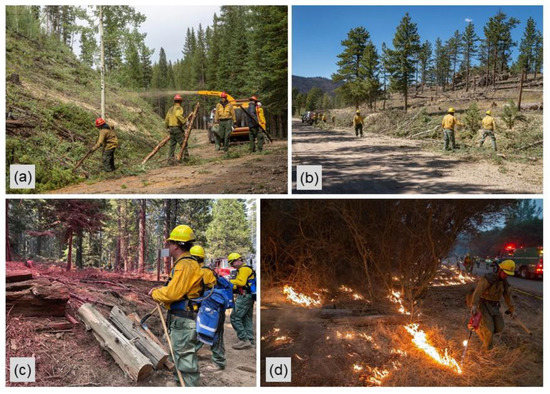
Figure 1.
Various forms of indirect fire line preparation using roads: (a,b) Roadside brushing and chipping; (c) Retardant application adjacent to road to be used as line; and (d) Burnout operation anchored to a road. All photos are from [21].
The intent of this communication is to illustrate by example how forest roads are considered in fire planning, leveraging the authors’ collective experience working with fire managers to deliver decision support. We focus on two interrelated products used on the National Forest System and adjacent lands throughout the western USA: (1) potential wildland fire operational delineations (PODs) and (2) potential control locations (PCLs). PODs are spatial units delineated by fire managers using potential fire control features (e.g., roads, ridge tops, streams, fuel transitions), within which relevant information on ecology, forest conditions, fire behavior, suppression difficulty, and wildfire risk can be summarized and then combined with local expertise to define strategic wildfire response objectives [22,23,24,25,26,27,28,29,30]. PODs development typically takes place in workshop settings that blend fire analytics with local expertise [31,32]. PODs are used as pre-season and during-incident spatial fire planning and communication tools [33,34,35,36,37]. In many landscapes, managers primarily identify roads to bound PODs, indicating that roads are commonly perceived to present the safest and most effective control features.
Current best practices for identifying PCLs augment local expert judgment with a machine learning algorithm to generate rasterized probability of control surfaces based on analysis of historical fire perimeters in relation to landscape features [38,39]. Raster PCL maps often support POD delineation, and they are generated upon request for real-time decision support on large and complex wildfire incidents [40]. Notably, distance to roads is consistently a significant predictor of fire perimeter locations across landscapes with different land cover types and fire regimes [23].
In the next section we contextualize these concepts based on the authors’ recent experiences working with the National Forest System managers and staff. Specifically, we illustrate how fire analytics and local fire managers both identified roads as primary control features. Lastly, we discuss recommendations for future research, emphasizing roles for enhanced decision support and empirical analysis.
2. Wildfire Response Planning on the Arapaho-Roosevelt National Forest, Colorado, USA
Here we review generation of a PCL raster to support spatial fire planning efforts, and the subsequent development of a network of PODs on the Canyon Lakes Ranger District (CLRD) of the Arapaho-Roosevelt National Forest in north-central Colorado. PODs were developed by fire and land managers associated with the National Forest and partnering agencies. Figure 2 presents a general workflow for the POD development process with three primary stages: (1) Prepare, in which the pre-work is accomplished to set the stage for successful workshops, including introducing key leaders and local experts to the process and generating fire analytics; (2) produce, in which PODs are generated and categorized by local experts in a workshop format; and (3) operationalize, in which PCLs and PODs are validated and integrated with plans and decision support systems [41]. In the paragraphs below we provide more detail on the prepare stage and specifically generation of the PCL raster. In the produce stage, we brought the PCL map to a workshop along with other spatial fire behavior products to support POD development. In an expert-driven process, local fire managers used the PCL raster in concert with knowledge about factors such as road condition and access, previously burned and treated areas, potential fire behavior, suppression difficulty, and values at risk to draw POD boundaries. Figure 3 displays the CLRD landscape with PODs overlaid; more details on the study area and POD development process are available in [26,42,43,44,45].
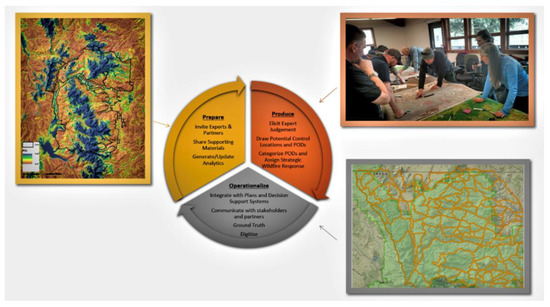
Figure 2.
General workflow of the potential wildland fire operational delineation (POD) development process, with figure insets for each stage displaying real-world examples of generated potential control locations (PCL) layers (prepare), manager workshops (produce), and final POD maps (operationalize) [41].
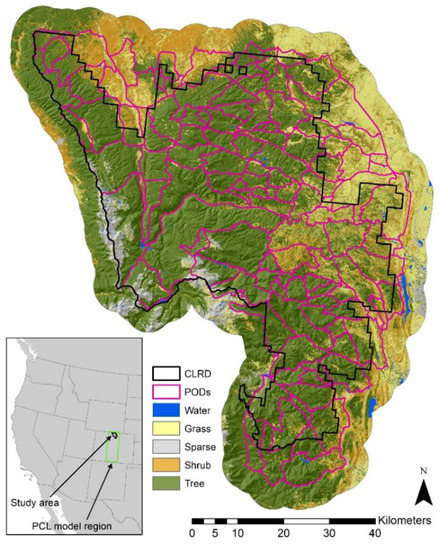
Figure 3.
Map of potential wildland fire operational delineations (PODs) delineated for the Canyon Lakes Ranger District of the Arapaho-Roosevelt National Forest in Northern Colorado. The inset shows the location of the study area and potential control location (PCL) model region in the western United States. Land cover is from LANDFIRE [52]. Note that POD boundaries, by design, cross the administrative boundaries of the Ranger District. The spatial datum and projection are North America 1983 Albers Conic Equal Area for this and following figures.
We modeled PCLs, a raster depiction of wildfire control probability, using the framework described by O’Connor et al. [39] for a broader area of central Colorado within and adjacent to the Arapaho-Roosevelt and Pike-San Isabel National Forests (Figure 3). This technique relates observations of fire control and lack of fire control from historical fire perimeters to landscape predictor variables with Boosted Regression [46]. The training dataset consisted of 33 wildfires that burned predominantly in forests (Appendix A, Figure A1). These wildfires burned a total of 1536 km2 with 1453 km of perimeter. Areas within 90 m of a fire perimeter were considered controlled (1) and burned interiors were considered uncontrolled (0). The predictors variables included: distance from major roads (roaddist); distance from waterbodies and large patches of non-burnable cover (barrierdist); a cost distance surface representing difficulty of firefighter travel across the landscape (costdist); a fuel type-based measure of resistance to control (RTC) [47]; distance from flat (flatdist), valley (valleydist), ridge (ridgedist), and steep (steepdist) topographic features defined with topographic position index [48]; an expert-based model of suppression difficulty index (SDI) [38,49]; and predicted fire rate of spread (ROS). See Table A1 in Appendix A and [39] for detailed descriptions of the predictor variables. Cost distance was limited to 30,000 (undefined units) and distance from roads was limited to 10,000 m to reduce the influence of extreme outliers. Fire behavior was modeled using FlamMap 5 [50] for a near worst-case weather scenario defined using historical fire season 3rd percentile fuel moisture (1-h: 2%, 10-h: 3%, 100-h: 6%, herbaceous: 30%, woody: 63%) and 97th percentile historical wind speeds (33.8 kph @ 6 m) at the modal wind direction (225 deg). LANDFIRE version 1.0.5 [51] was used for generating the predictor variables and LANDFIRE version 1.4.0 [52] updated with recent fuel changes to circa 2018 was used to project PCL onto the current landscape. We used the gbm package [53] implementation of boosted regression in R [54] to model the relationship between control probability and predictor variables. The model was developed from 82,828 observation points randomly sampled from the historical fires with a minimum spacing of 60 m, of which, 12,564 were observations associated with fire control. We used the same boosted regression settings as [39], which include a bagging fraction of 0.5, a learning rate of 0.005, and a tree complexity of 5. The final boosted regression model consisted of 10,550 trees and had a receiver operator curve (ROC) score of 0.734 based on 10-fold cross validation.
Figure 4 depicts PCL results for the CLRD. Areas of cooler colors, reflecting greater probability of control, tend to align with river and road corridors and areas with no or sparse fuels above upper tree line. The bar chart inset in panel (a) shows the relative importance (RI) of predictor variables. Notably, distance to roads (RI = 22.6%) and barriers to fire spread (RI = 14.9%) were the most important predictor variables, followed by accessibility (costdist), then fire behavior and topographic variables. In general, the model predicts higher potential for control close to roads and barriers and at low levels of RTC and SDI.
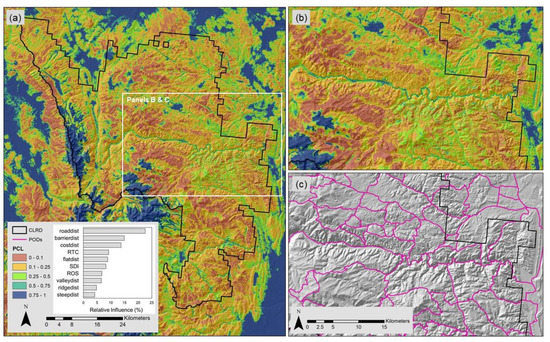
Figure 4.
Potential Control Location (PCL) raster generated to support potential wildland fire operational delineation (POD) development for the Canyon Lakes Ranger District (CLRD) of the Arapaho-Roosevelt National Forest in Northern Colorado. Panel (a) indicates the locations of the other panels on the landscape and depicts a bar chart with the relative influence of final predictor variables in the boosted regression tree model. Panels (b,c) show with greater detail how areas of low PCL (top) tend to align with manager-selected POD boundaries (bottom). Panels (b,c) also show how POD boundaries span administrative CLRD boundaries.
Comparison of panel (b) and panel (c) in Figure 4 indicates the strong alignment of high PCL features with manager-selected POD boundaries. All told the CLRD network consists of 121 PODs that range in size from to 281 to 23,672 ha (mean 3634 ha) covering a total of 4397 km2. The PODs are bounded by 2112 km of PCLs. Roads make up the vast majority of POD boundaries (81.8% by length), followed by trails (8.7%), and ridges (3.8%) (Table 1). Managers likely exhibited a strong preference for roads and trails because accessibility is a major constraint on firefighting operations due to the rugged topography. Roads are also viewed as the safest locations to engage with fires in the large portion of the CLRD where abundant standing and fallen dead trees from recent outbreaks of mountain pine beetle and spruce beetle impede cross country travel and increase firefighter hazards [55].

Table 1.
Accounting of control features selected to bound potential wildland fire operational delineations (PODs) on the Canyon Lakes Ranger District (CLRD). Grey italics indicate subcategories of roads.
3. Wildfire Response on the Arapaho-Roosevelt National Forest: Cameron Peak Fire
On 13 August 2020, the Cameron Peak Fire ignited near the edge of a remote POD on the CLRD. Over the course of several months, driven by a combination of dry fuels and extreme wind events, the Cameron Peak Fire grew to become the largest fire in the history of the state of Colorado exceeding 80,000 ha and resulting in multiple evacuations and substantial structure loss (https://inciweb.nwcg.gov/incident/6964/, accessed on 19 January 2021). The fire spotted across a paved highway and adjacent river that form the boundaries of several PODs. Similar behavior has been observed in this landscape during the 2011 Crystal Fire and the 2013 High Park Fire.
A range of advanced decision support tools were deployed during the incident, including updated PCL maps provided by the agency’s Risk Management Assistance program [56]. Additionally, some of the co-authors were involved in assessing and interpreting PCL values for various road segments and POD edges to aid incident response decisions such as locating contingency lines. In future research we plan to examine the utility of forest roads, PCLs, and PODs in supporting incident management on the Cameron Peak Fire, which will necessitate extensive collection and analysis of spatial incident data along with interviews with local managers and out-of-area Incident Commanders (see [57,58]). Preliminary analysis indicates some alignment of the fire perimeter with roads (e.g., Figure 5). Further, preliminary analysis indicates strong alignment of roads with intended control features for indirect and contingency line. We interpret these results to underscore the importance of indirect tactics for containing large fires and the associated utility of pre-identifying suitable PCLs.
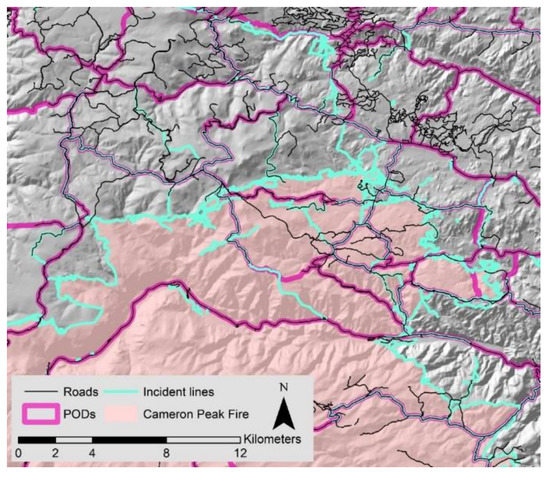
Figure 5.
Map of the northern portion of the Cameron Peak Fire, potential wildland fire operational delineation (POD) boundaries, local roads, and incident lines (control lines and roads improved for access documented by the management team).
4. Discussion
The case study presented here illustrates the value of forest roads in operational wildfire response planning—as identified by both local managers and advanced fire analytics—and highlights several avenues of future research. As stated above, one opportunity lies with in-depth case studies of individual fires, but there would also be value to continued systematic review accounting for differences in factors like modern fire regimes, fuel continuity, presence of other natural or built barriers, road density, proximity to values-at-risk, and, critically, information on suppression operations. Open questions include the impacts of road decommissioning and backlogged maintenance on control operations, the effects of road size and density on suppression firing opportunities, and how much of historical alignment between roads and fire perimeters is due to the road acting as a barrier to low intensity fire spread, due to the presence of suppression resources such as engines or hose lays, or due to use of roads as anchors for intentional firing operations. Management of forest road networks with fire control in mind could be particularly relevant to the USDA Forest Service, which is actively decommissioning roads to reduce sediment production and reduce road-stream connectivity [59]. Further, a substantial deferred maintenance backlog could inhibit heavy machinery access (https://www.fs.usda.gov/inside-fs/leadership/reducing-our-deferred-maintenance-backlog; accessed on 19 January 2021). Further, research could ask under what range of conditions roads effectively operate as controls, what are the root causes of failure (e.g., spotting), and how to better predict risks of failure [16,17,24].
Several opportunities for enhanced decision support are apparent. A near-term step is to compile best practices for PCL and POD workflows, for example attributing and rating PCLs according to suitability for various resources and tactics. Building from the work of [9,10] and others, decision models of road maintenance, upgrading, and closure could be developed and optimized from the perspective of maximizing firefighting access, coverage, and egress. Another management focus could be scheduling harvest along roads to enhance control opportunities [60], entailing decision variables related to cut depth, maintenance, and silvicultural prescription, and objective functions including harvest volume, cost, and reduction in fire intensity. A related optimization model for real-time decision support could build from the POD-based work of [28,29,30] to embed spatial dynamics of fire growth in relation to roads and PCLs and include time windows for prepping roads to enhance control probability. As these frameworks develop, so too hopefully will the empirical basis to calibrate and validate them, notably addressing knowledge gaps around suppression resource productivity and effectiveness [7,18,20].
5. Conclusions
In an era of potentially increasing fire hazard and risk, the importance of decision support tools to support safe and effective fire control is growing. As previous research has indicated, roads can strongly influence fire activity and fire control tactics, highlighting the critical role for forest road network analysis and planning in wildfire management. In this communication we highlighted recent developments in operationally focused wildfire decision support from the USA, focusing on how fire analytics and expert judgment both identify roads as suitable control features. We believe the basic workflows and insights are translatable to fire-prone landscapes around the globe, and hope the work stimulates additional research linking forest engineering with fire operations.
Author Contributions
Conceptualization, M.P.T.; methodology, M.P.T., B.M.G., and M.D.C.; formal analysis, B.M.G., M.D.C.; writing—original draft preparation, M.P.T.; writing—review and editing, M.P.T., B.M.G. and M.D.C.; project administration, M.P.T. All authors have read and agreed to the published version of the manuscript.
Funding
This project is funded by the Joint Venture Agreement between the USDA Forest Service Rocky Mountain Research Station and Colorado State University.
Institutional Review Board Statement
Not applicable.
Informed Consent Statement
Not applicable.
Data Availability Statement
Data available upon request.
Acknowledgments
We wish to thank the leadership and staff of the Arapaho-Roosevelt National Forest and the Wildfire Risk Management Science Team. This research was supported by the U.S. Department of Agriculture, Forest Service.
Conflicts of Interest
The authors declare no conflict of interest.
Disclaimer
The findings and conclusions in this paper are those of the author(s) and should not be construed to represent any official USDA or U.S. Government determination or policy.
Appendix A
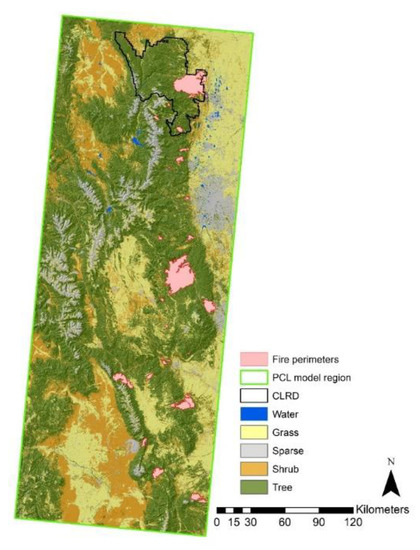
Figure A1.
Map of the 33 historical fire perimeters used in the PCL analysis from MTBS [61] and GeoMAC [62]. Land cover is from LANDFIRE [51]. The spatial datum and projection are North America 1983 Albers Conic Equal Area.

Table A1.
Summary of methods used to generate the predictor variable raster layers used in the PCL analysis.
Table A1.
Summary of methods used to generate the predictor variable raster layers used in the PCL analysis.
| Layer | Description | Data Sources |
|---|---|---|
| roaddist | Euclidean distance (m) from major roads defined as speed categories 1–5 (highest speeds). | NAVTEQ/HERE road polylines (here.com) |
| barrierdist | Euclidean distance (m) from waterbodies and large patches of non-burnable cover. Waterbodies include perennial streams, rivers, lakes, reservoirs, swamps, and marshes. Large patches of non-burnable cover were defined as contiguous areas of non-burnable fuels ≥ 1.8 ha. | National hydrography dataset (usgs.gov/core-science-systems/ngp/national-hydrography), LANDFIRE fuels (landfire.gov) |
| costdist | Least cost distance (unitless) from major roads accounting for firefighter travel resistance factors like O’Connor et al. (2017). Resistance factors (in parentheses) account for minor roads (2), trails (4), no roads or trails (10), increasing travel difficulty with slope (1–16), and increasing travel difficulty with waterbody width and depth (5–30). Resistance factors are summed except for minor roads and trails. | NAVTEQ/HERE road polylines (here.com), USFS trail polylines (https://data.fs.usda.gov/geodata/), National hydrography dataset (usgs.gov/core-science-systems/ngp/national-hydrography), LANDFIRE topography (landfire.gov) |
| RTC | Resistance to control was calculated by fire behavior fuel model using the inverse of fireline production rates from Dillon et al. (2015) converted first to m h−1. | LANDFIRE fuels (landfire.gov) |
| flatdist | Euclidean distance (m) from flat topography defined as topographic position index (TPI) (Weiss 2001) between −12 and 12, and slope ≤ 6 deg. | LANDFIRE topography (landfire.gov) |
| valleydist | Euclidean distance (m) from valleys defined as TPI < −12. | LANDFIRE topography (landfire.gov) |
| ridgedist | Euclidean distance (m) from ridges defined as TPI > 12. | LANDFIRE topography (landfire.gov) |
| steepdist | Euclidean distance (m) from steep topography defined as TPI between −12 and 12, and slope > 6 deg. | LANDFIRE topography (landfire.gov) |
| SDI | Relative measure of ground resource suppression difficulty index (SDI) from Rodríguez y Silva et al. (2014). SDI is calculated by dividing an energy behavior index based on flame length and heat per unit area by the sum of indices for accessibility, penetrability, mobility, and fireline construction ease. The fire behavior inputs were modeled using FlamMap 5.0 (Finney et al. 2015) for historical fire season 3rd percentile fuel moisture and 97th percentile wind speeds. | NAVTEQ/HERE road polylines (here.com), USFS trail polylines (https://data.fs.usda.gov/geodata/), LANDFIRE fuels and topography (landfire.gov), RAWS (raws.nifc.gov) |
| ROS | Fire rate of spread (ROS) (chains h−1) was modeled using FlamMap 5.0 (Finney et al. 2015) for historical fire season 3rd percentile fuel moisture and 97th percentile wind speeds. | LANDFIRE (landfire.gov), RAWS (raws.nifc.gov) |
References
- Ascoli, D.; Russo, L.; Giannino, F.; Siettos, C.; Moreira, F. Firebreak and Fuelbreak. In Encyclopedia of Wildfires and Wildland-Urban Interface (WUI) Fires; Manzello, S., Ed.; Springer: Cham, Germany, 2018. [Google Scholar] [CrossRef]
- Hegg, B. Burn Out and Backfire/Backfiring. In Encyclopedia of Wildfires and Wildland-Urban Interface (WUI) Fires; Manzello, S., Ed.; Springer: Cham, Germany, 2020. [Google Scholar] [CrossRef]
- Narayanaraj, G.; Wimberly, M.C. Influences of forest roads on the spatial pattern of wildfire boundaries. Int. J. Wildland Fire 2011, 20, 792–803. [Google Scholar] [CrossRef]
- Narayanaraj, G.; Wimberly, M.C. Influences of forest roads on the spatial patterns of human-and lightning-caused wildfire ignitions. Appl. Geogr. 2012, 32, 878–888. [Google Scholar] [CrossRef]
- Yocom, L.L.; Jenness, J.; Fulé, P.Z.; Thode, A.E. Previous fires and roads limit wildfire growth in Arizona and New Mexico, USA. For. Ecol. Manag. 2019, 449, 117440. [Google Scholar] [CrossRef]
- Katuwal, H.; Calkin, D.E.; Hand, M.S. Production and efficiency of large wildland fire suppression effort: A stochastic frontier analysis. J. Environ. Manag. 2016, 166, 227–236. [Google Scholar] [CrossRef] [PubMed]
- Simpson, H.; Bradstock, R.; Price, O. A temporal framework of large wildfire suppression in practice, a qualitative descriptive study. Forests 2019, 10, 884. [Google Scholar] [CrossRef]
- Sakellariou, S.; Samara, F.; Tampekis, S.; Sfougaris, A.; Christopoulou, O. Development of a Spatial Decision Support System (SDSS) for the active forest-urban fires management through location planning of mobile fire units. Environ. Hazards 2020, 19, 131–151. [Google Scholar] [CrossRef]
- Akay, A.E.; Wing, M.G.; Sivrikaya, F.; Sakar, D. A GIS-based decision support system for determining the shortest and safest route to forest fires: A case study in Mediterranean Region of Turkey. Environ. Monit. Assess. 2012, 184, 1391–1407. [Google Scholar] [CrossRef]
- Akay, A.E.; Wing, M.G.; Zengin, M.; Kose, O. Determination of fire-access zones along road networks in fire-sensitive forests. J. For. Res. 2017, 28, 557–564. [Google Scholar] [CrossRef]
- Laschi, A.; Foderi, C.; Fabiano, F.; Neri, F.; Cambi, M.; Mariotti, B.; Marchi, E. Forest road planning, construction and maintenance to improve forest fire fighting: A review. Croat. J. For. Eng. 2019, 40, 207–219. [Google Scholar]
- Mostafa, M.; Shataee Jouibary, S.; Lotfalian, M.; Sadoddin, A. Watershed road network analysis with an emphasis on fire fighting management. J. Environ. Eng. Landsc. Manag. 2017, 25, 342–353. [Google Scholar] [CrossRef]
- Stefanović, B.; Stojnić, D.; Danilović, M. Multi-criteria forest road network planning in fire-prone environment: A case study in Serbia. J. Environ. Plan. Manag. 2016, 59, 911–926. [Google Scholar] [CrossRef]
- Demir, M.; Kucukosmanoglu, A.; Hasdemir, M.; Acar, H.; Ozturk, T. Assessment of forest roads and firebreaks in Turkey. Afr. J. Biotechnol. 2009, 8, 4553–4561. [Google Scholar]
- Syphard, A.D.; Keeley, J.E.; Brennan, T.J. Factors affecting fuel break effectiveness in the control of large fires on the Los Padres National Forest, California. Int. J. Wildland Fire 2011, 20, 764–775. [Google Scholar] [CrossRef]
- Mees, R.; Strauss, D.; Chase, R. Modeling wildland fire containment with uncertain flame length and fireline width. Int. J. Wildland Fire 1993, 3, 179–185. [Google Scholar] [CrossRef]
- Wilson, A.A. Width of firebreak that is necessary to stop grass fires: Some field experiments. Can. J. For. Res. 1988, 18, 682–687. [Google Scholar] [CrossRef]
- Plucinski, M.P. Contain and control: Wildfire suppression effectiveness at incidents and across landscapes. Curr. For. Rep. 2019, 5, 20–40. [Google Scholar] [CrossRef]
- Gannon, B.M.; Thompson, M.P.; Deming, K.Z.; Bayham, J.; Wei, Y.; O’Connor, C.D. A geospatial framework to assess fireline effectiveness for large wildfires in the western USA. Fire 2020, 3, 43. [Google Scholar] [CrossRef]
- Thompson, M.P.; Lauer, C.J.; Calkin, D.E.; Rieck, J.D.; Stonesifer, C.S.; Hand, M.S. Wildfire response performance measurement: Current and future directions. Fire 2018, 1, 21. [Google Scholar] [CrossRef]
- Available online: https://inciweb.nwcg.gov/ (accessed on 6 December 2020).
- Dunn, C.J.; Thompson, M.P.; Calkin, D.E. A framework for developing safe and effective large-fire response in a new fire management paradigm. For. Ecol. Manag. 2017, 404, 184–196. [Google Scholar] [CrossRef]
- Dunn, C.J.; O’Connor, C.; Abrams, J.; Thompson, M.P.; Calkin, D.E.; Johnston, J.D.; Stratton, R.; Gilbertson-Day, J. Wildfire risk science facilitates adaptation of fire-prone social-ecological systems to the new fire reality. Environ. Res. Lett. 2020, 15, 25001. [Google Scholar] [CrossRef]
- Gannon, B.M.; Wei, Y.; Thompson, M.P. Mitigating source water risks with improved wildfire containment. Fire 2020, 3, 45. [Google Scholar] [CrossRef]
- Thompson, M.P.; Bowden, P.; Brough, A.; Scott, J.H.; Gilbertson-Day, J.; Taylor, A.; Anderson, J.; Haas, J.R. Application of wildfire risk assessment results to wildfire response planning in the southern Sierra Nevada, California, USA. Forests 2016, 7, 64. [Google Scholar] [CrossRef]
- Thompson, M.P.; Liu, Z.; Wei, Y.; Caggiano, M.D. Analyzing wildfire suppression difficulty in relation to protection demand. Environ. Risks 2018, 45–64. Available online: https://www.intechopen.com/books/environmental-risks/analyzing-wildfire-suppression-difficulty-in-relation-to-protection-demand (accessed on 7 December 2020).
- Thompson, M.P.; MacGregor, D.G.; Dunn, C.J.; Calkin, D.E.; Phipps, J. Rethinking the wildland fire management system. J. For. 2018, 116, 382–390. [Google Scholar] [CrossRef]
- Wei, Y.; Thompson, M.P.; Haas, J.R.; Dillon, G.K.; O’Connor, C.D. Spatial optimization of operationally relevant large fire confine and point protection strategies: Model development and test cases. Can. J. For. Res. 2018, 48, 480–493. [Google Scholar] [CrossRef]
- Wei, Y.; Thompson, M.P.; Scott, J.H.; O’Connor, C.D.; Dunn, C.J. Designing operationally relevant daily large fire containment strategies using risk assessment results. Forests 2019, 10, 311. [Google Scholar] [CrossRef]
- Wei, Y.; Thompson, M.P.; Belval, E.; Gannon, B.; Calkin, D.E.; O’Connor, C.D. Comparing contingency fire containment strategies using simulated random scenarios. Nat. Resour. Model. 2020, e12295. Available online: https://onlinelibrary.wiley.com/doi/full/10.1111/nrm.12295 (accessed on 7 December 2020).
- Thompson, M.P.; Wei, Y.; Calkin, D.E.; O’Connor, C.D.; Dunn, C.J.; Anderson, N.M.; Hogland, J.S. Risk management and analytics in wildfire response. Curr. For. Rep. 2019, 5, 226–239. [Google Scholar] [CrossRef]
- Available online: https://usfs.maps.arcgis.com/apps/Cascade/index.html?appid=073b66277b6540328f40b772dfab7c6f (accessed on 6 December 2020).
- Caggiano, M.D.; O’Connor, C.D.; Sack, R.B. Potential Operational Delineations and Northern New Mexico’s 2019 Fire Season; CFRI-2002; Colorado Forest Restoration Institute: Colorado, CO, USA, 2020. [Google Scholar]
- O’Connor, C.D.; Calkin, D.E. Engaging the fire before it starts: A case study from the 2017 Pinal Fire (Arizona). Wildfire 2019, 28, 14–18. [Google Scholar]
- Greiner, M.; Schultz, C.; Kooistra, C. Pre-season fire management planning: The use of Potential Operational Delineations (PODs) to prepare for wildland fire events. Int. J. Wildland Fire 2020. [Google Scholar] [CrossRef]
- Steelman, T.; Nowell, B. Evidence of effectiveness in the Cohesive Strategy: Measuring and improving wildfire response. Int. J. Wildland Fire 2019, 28, 267–274. [Google Scholar] [CrossRef]
- Stratton, R.D. The path to strategic wildland fire management planning. Wildfire Mag 2020, 29, 24–31. [Google Scholar]
- O’Connor, C.D.; Thompson, M.P.; Rodríguez y Silva, F. Getting ahead of the wildfire problem: Quantifying and mapping management challenges and opportunities. Geosciences 2016, 6, 35. [Google Scholar] [CrossRef]
- O’Connor, C.D.; Calkin, D.E.; Thompson, M.P. An empirical machine learning method for predicting potential fire control locations for pre-fire planning and operational fire management. Int. J. Wildland Fire 2017, 26, 587–597. [Google Scholar] [CrossRef]
- Schultz, C.; Kooistra, C.; Miller, L.; Ferguson, M. Findings from a Third-Party Assessment of the Forest Service’s Risk Management Assistance Team. CSU Public Lands Policy Group Practitioner Paper 4: 2020. Available online: https://sites.warnercnr.colostate.edu/courtneyschultz/practitioner-papers/ (accessed on 7 December 2020).
- Strategic, Cross-Boundary Wildfire Response Planning: A Story Map. USDA Forest Service Rocky Mountain Research Station, Wildfire Risk Management Science Team. Available online: https://usfs.maps.arcgis.com/apps/Cascade/index.html?appid=073b66277b6540328f40b772dfab7c6f (accessed on 19 January 2021).
- Addington, R.N.; Aplet, G.H.; Battaglia, M.A.; Briggs, J.S.; Brown, P.M.; Cheng, A.S.; Dickinson, Y.; Feinstein, J.A.; Peiz, K.A.; Regan, C.M.; et al. Principles and practices for the restoration of ponderosa pine and dry mixed-conifer forests of the Colorado Front Range. US Dep. Agric. For. Serv. Rocky Mt. Res. Stn. 2018, 121, 373. [Google Scholar]
- Schoennagel, T.; Veblen, T.T.; Romme, W.H. The interaction of fire, fuels, and climate across Rocky Mountain forests. BioScience 2004, 54, 661–676. [Google Scholar] [CrossRef]
- Sherriff, R.L.; Veblen, T.T. A spatially-explicit reconstruction of historical fire occurrence in the ponderosa pine zone of the Colorado Front Range. Ecosystems 2007, 10, 311–323. [Google Scholar] [CrossRef]
- Thompson, M.P.; Gannon, B.M.; Caggiano, M.D.; O’Connor, C.D.; Brough, A.; Gilbertson-Day, J.W.; Scott, J.H. Prototyping a Geospatial Atlas for Wildfire Planning and Management. Forests 2020, 11, 909. [Google Scholar] [CrossRef]
- Elith, J.; Leathwick, J.R.; Hastie, T. A working guide to boosted regression trees. J. Anim. Ecol. 2008, 77, 802–813. [Google Scholar] [CrossRef]
- Dillon, G.K.; Menakis, J.; Fay, F. Wildland fire potential: A tool for assessing wildfire risk and fuels management needs. In Proceedings of the large wildland fires conference, Missoula, MT, USA, 19–23 May 2014; Keane, R.E., Jolly, M., Parsons, R., Riley, K., Eds.; USDA Forest Service, Rocky Mountain Research Station: Fort Collins, CO, USA; pp. 60–76. [Google Scholar]
- Weiss, A.D. Topographic position and landforms analysis. In Proceedings of the Conference poster for ‘21st Annual ESRI International User Conference’, San Diego, CA, USA, 9–13 July 2001; Available online: http://www.jennessent.com/arcview/TPI_Weiss_poster.htm (accessed on 25 November 2020).
- Rodríguez y Silva, F.; Martínez, J.R.M.; González-Cabán, A. A methodology for determining operational priorities for prevention and suppression of wildland fires. Int. J. Wildland Fire 2014, 23, 544–554. [Google Scholar] [CrossRef]
- Finney, M.A.; Brittain, S.; Seli, R.C.; McHugh, C.W.; Gangi, L. FlamMap: Fire Mapping and Analysis System; (Version 5.0); USDA Forest Service, Rocky Mountain Research Station: Missoula, MT, USA, 2015; Available online: http://www.firelab.org/document/flammap-software (accessed on 25 November 2020).
- LANDFIRE. Fuel and Topography Layers, LANDFIRE 1.0.5. US Geological Survey. 2001. Available online: http://landfire.cr.usgs.gov/viewer/ (accessed on 25 November 2020).
- LANDFIRE. Fuel and Topography Layers, LANDFIRE 1.4.0. US Geological Survey. 2014. Available online: http://landfire.cr.usgs.gov/viewer/ (accessed on 25 November 2020).
- Greenwell, B.; Boehmke, B.; Cunningham, J. Gbm: Generalized Boosted Regression Models. R Package Version 2.1.3. 2017. Available online: https://cran.r-project.org/web/packages/gbm/index.html (accessed on 25 November 2020).
- R Core Team. R: A Language and Environment for Statistical Computing; R Foundation for Statistical Computing: Vienna, Austria, 2018. Available online: https://www.R-project.org/ (accessed on 25 November 2020).
- Moriarty, K.; Cheng, A.S.; Hoffman, C.M.; Cottrell, S.P.; Alexander, M.E. Firefighter observations of “surprising” fire behavior in mountain pine beetle-attacked lodgepole pine forests. Fire 2019, 2, 34. [Google Scholar] [CrossRef]
- Risk Management Assistance Dashboard. Available online: https://nifc.maps.arcgis.com/apps/MapSeries/index.html?appid=c5bc811ee22e4da0bde8abec7c20b8b4 (accessed on 19 January 2021).
- Kolden, C.A.; Henson, C. A socio-ecological approach to mitigating wildfire vulnerability in the wildland urban interface: A case study from the 2017 Thomas fire. Fire 2019, 2, 9. [Google Scholar] [CrossRef]
- Thompson, M.P.; Freeborn, P.; Rieck, J.D.; Calkin, D.E.; Gilbertson-Day, J.W.; Cochrane, M.A.; Hand, M.S. Quantifying the influence of previously burned areas on suppression effectiveness and avoided exposure: A case study of the Las Conchas Fire. Int. J. Wildland Fire 2016, 25, 167–181. [Google Scholar] [CrossRef]
- Sosa-Pérez, G.; MacDonald, L.H. Reductions in road sediment production and road-stream connectivity from two decommissioning treatments. For. Ecol. Manag. 2017, 398, 116–129. [Google Scholar] [CrossRef]
- Ager, A.A.; Vaillant, N.M.; McMahan, A. Restoration of fire in managed forests: A model to prioritize landscapes and analyze tradeoffs. Ecosphere 2013, 4, 1–19. [Google Scholar] [CrossRef]
- MTBS. Monitoring Trends in Burn Severity. Available online: https://www.mtbs.gov/ (accessed on 19 January 2021).
- GeoMAC. Geospatial Multi-Agency Coordination Undergoing Transition. Available online: https://www.geomac.gov/;https://www.geomac.gov/GeoMACTransition.shtml (accessed on 19 January 2021).
Publisher’s Note: MDPI stays neutral with regard to jurisdictional claims in published maps and institutional affiliations. |
© 2021 by the authors. Licensee MDPI, Basel, Switzerland. This article is an open access article distributed under the terms and conditions of the Creative Commons Attribution (CC BY) license (http://creativecommons.org/licenses/by/4.0/).